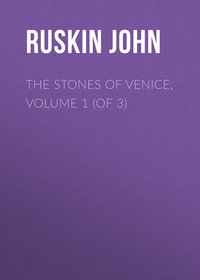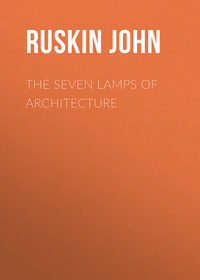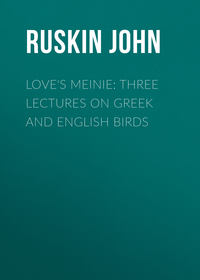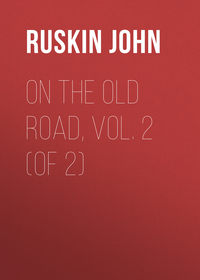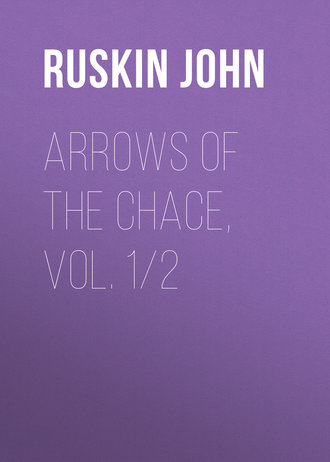 полная версия
полная версияArrows of the Chace, vol. 1/2

John Ruskin
Arrows of the Chace, vol. 1/2 / being a collection of scattered letters published chiefly / in the daily newspapers 1840-1880
AUTHOR’S PREFACE
My good Editor insists that this book must have an Author’s Preface; and insists further that it shall not contain compliments to him on the editorship. I must leave, therefore, any readers who care for the book, and comprehend the trouble that has been spent on it, to pay him their own compliments, as the successive service of his notes may call for them: but my obedience to his order, not in itself easy to me, doubles the difficulty I have in doing what, nevertheless, I am resolved to do—pay, that is to say, several extremely fine compliments to myself, upon the quality of the text.
For of course I have read none of these letters since they were first printed: of half of them I had forgotten the contents, of some, the existence; all come fresh to me; and here in Rouen, where I thought nothing could possibly have kept me from drawing all I could of the remnants of the old town, I find myself, instead, lying in bed in the morning, reading these remnants of my old self—and that with much contentment and thankful applause.
For here are a series of letters ranging over a period of, broadly, forty years of my life; most of them written hastily, and all in hours snatched from heavier work: and in the entire mass of them there is not a word I wish to change, not a statement I have to retract, and, I believe, few pieces of advice, which the reader will not find it for his good to act upon.
With which brief preface I am, for my own part, content; but as it is one of an unusual tenor, and may be thought by some of my friends, and all my foes, more candid than graceful, I permit myself the apologetic egotism of enforcing one or two of the points in which I find these letters so well worth—their author’s—reading.
In the building of a large book, there are always places where an indulged diffuseness weakens the fancy, and prolonged strain subdues the energy: when we have time to say all we wish, we usually wish to say more than enough; and there are few subjects we can have the pride of exhausting, without wearying the listener. But all these letters were written with fully provoked zeal, under strict allowance of space and time: they contain the choicest and most needful things I could within narrow limits say, out of many contending to be said; expressed with deliberate precision; and recommended by the best art I had in illustration or emphasis. At the time of my life in which most of them were composed, I was fonder of metaphor, and more fertile in simile, than I am now; and I employed both with franker trust in the reader’s intelligence. Carefully chosen, they are always a powerful means of concentration; and I could then dismiss in six words, “thistledown without seeds, and bubbles without color,” forms of art on which I should now perhaps spend half a page of analytic vituperation; and represent, with a pleasant accuracy which my best methods of outline and exposition could now no more achieve, the entire system of modern plutocratic policy, under the luckily remembered image of the Arabian bridegroom, bewitched with his heels uppermost.
It is to be remembered also that many of the subjects handled can be more conveniently treated controversially than directly; the answer to a single question may be made clearer than a statement which endeavors to anticipate many; and the crystalline vigor of a truth is often best seen in the course of its serene collision with a trembling and dissolving fallacy. But there is a deeper reason than any such accidental ones for the quality of this book. Since the letters cost me, as aforesaid, much trouble; since they interrupted me in pleasant work which was usually liable to take harm by interruption; and since they were likely almost, in the degree of their force, to be refused by the editors of the adverse journals, I never was tempted into writing a word for the public press, unless concerning matters which I had much at heart. And the issue is, therefore, that the two following volumes contain very nearly the indices of everything I have deeply cared for during the last forty years; while not a few of their political notices relate to events of more profound historical importance than any others that have occurred during the period they cover; and it has not been an uneventful one.
Nor have the events been without gravity; the greater, because they have all been inconclusive. Their true conclusions are perhaps nearer than any of us apprehend; and the part I may be forced to take in them, though I am old,—perhaps I should rather say, because I am old,—will, as far as I can either judge or resolve, be not merely literary.
Whether I am spared to put into act anything here designed for my country’s help, or am shielded by death from the sight of her remediless sorrow, I have already done for her as much service as she has will to receive, by laying before her facts vital to her existence, and unalterable by her power, in words of which not one has been warped by interest nor weakened by fear; and which are as pure from selfish passion as if they were spoken already out of another world.
J. Ruskin.Rouen, St. Firmin’s Day, 1880.
EDITOR’S PREFACE
Some words are needed by way of a general note to the present volumes in explanation of the principles upon which they have been edited. It is, however, first due to the compiler of the Bibliography of Mr. Ruskin’s writings,1 to state in what measure this book has been prompted and assisted by his previous labors. Already acquainted with some few of the letters which Mr. Ruskin had addressed at various times to the different organs of the daily press, or which had indirectly found their way there, it was not until I came across the Bibliography that I was encouraged to complete and arrange a collection of these scattered portions of his thought. When I had done this, I ventured to submit the whole number of the letters to their author, and to ask him if, after taking two or three of them as examples of the rest, he would not consider the advisability of himself republishing, if not all, at least a selected few. In reply, he was good enough to put me in communication with his publisher, and to request me to edit any or all of the letters without further reference to him.
I have, therefore, to point out that except for that request, or rather sanction; for the preface which he has promised to add after my work upon the volumes is finished; and for the title which it bears, Mr. Ruskin is in no way responsible for this edition of his letters. I knew, indeed, from the words of “Fors Clavigera” which are printed as a motto to the book, that I ran little risk of his disapproval in determining to print, not a selection, but the whole number of letters in question; and I felt certain that the completeness of the collection would be considered a first essential by most of its readers, who are thus assured that the present volumes contain, with but two exceptions, every letter mentioned in the last edition of the bibliography, and some few more beside, which have been either printed or discovered since its publication.
The two exceptions are, first, the series of letters on the Lord’s Prayer which appeared in the pages of the Contemporary Review last December; and, secondly, some half-dozen upon “A Museum or Picture Gallery,” printed in the Art Journal of last June and August. It seemed that both these sets of letters were really more akin to review articles cast in an epistolary form, and would thus find fitter place in a collection of such papers than in the present volumes; and for the omission of the second set there was a still further reason in the fact that the series is not yet completed.2 On the other hand, the recent circular on the proposed interference with St. Mark’s, Venice, is included in the first, and one or twoother extraneous matters in the second volume, for reasons which their connection with the letters amongst which they are placed will make sufficiently clear.
The letters are reprinted word for word, and almost stop for stop, from the newspapers and other pages in which they first appeared. To ensure this accuracy was not an easy matter, and to it there are a few intentional exceptions. A few misprints have been corrected, such as that of “Fat Bard” for “Fort Bard” (vol. i. p. 147): and now and then the punctuation has been changed, as on the 256th page of the same volume, where a comma, placed in the original print of the letter between the words “visibly” and “owing,” quite confused the sentence. To these slight alterations may be added others still less important, such as the commencement of a fresh paragraph, or the closing up of an existing one, to suit the composition of the type, which the number of notes rendered unusually tiresome. The title of a letter, too, is not always that provided it by the newspaper; in some cases it seemed well to rechristen, in others it was necessary to christen a letter, though the former has never been done where it was at all possible that the existing title (for which reference can always be made to the bibliography) was one given to it by Mr. Ruskin himself.
The classification of the letters is well enough shown by the tables of contents. The advantages of a topical over a chronological arrangement appeared beyond all doubt; whilst the addition to each volume of a chronological list of the letters contained in it, and the further addition to the second volume of a similar list of all the letters contained in the book, and of a full index, will, it is hoped, increase the usefulness of the work.
The beautiful engraving which forms the frontispiece of the first volume originally formed that of “The Oxford Museum.” The plate was but little used in the apparently small edition of that book, and was thus found to be in excellent state for further use here. The woodcut of the chestnut spandril (vol. i. p. 144) is copied from one which may also be found in “The Oxford Museum.” The facsimile of part of one of the letters is not quite satisfactory, the lines being somewhat thicker than they should be, but it answers its present purpose.
Lastly, the chief difficulty of editing these letters has been in regard to the notes, and has lain not so much in obtaining the necessary information as in deciding what use to make of it when obtained. The first point was, of course, to put the reader of the present volumes in possession of every fact which would have been common knowledge at the time when such and such a letter was written; but beyond this there were various allusions, which might be thought to need explanation; quotations, the exact reference to which might be convenient; and so forth. Some notes, therefore, of this character have been also added; whilst some few which were omitted, either intentionally or by accident, from the body of the work, may be found on reference to the index.3
The effort to make the book complete has induced the notice of slight variations of text in one or two cases, especially in the reprint of the St. Mark’s Circular. The space occupied by such notes is small, the interest which a few students take in the facts they notice really great, and the appearance of pedantry to some readers is thus risked in order to meet the special wish of others. The same effort will account for the reappearance of one or two really unimportant letters in the Appendix to the second volume, which contains also some few letters the nature of which is rather personal than public.
I have asked Mr. Ruskin to state in his preface to the book the value he may set upon it in relation to his other and more connected work; and for the rest, I have only to add that the editing of it has been the pleasant labor of my leisure for more than two years past, and to express my hope that these scattered arrows, some from the bow of “An Oxford Graduate,” some from that of an Oxford Professor, may not have been vainly winged anew by
An Oxford Pupil.October, 1880.
LETTERS ON ART
I.
ART CRITICISM AND ART EDUCATION
[From “The Weekly Chronicle,” September 23, 1843.]
“MODERN PAINTERS;” A REPLY
To the Editor of “The Weekly Chronicle.”
Sir: I was much gratified by reading in your columns of the 15th4 instant a piece of close, candid, and artistical criticism on my work entitled “Modern Painters.” Serious and well-based criticism is at the present day so rare, and our periodicals are filled so universally with the splenetic jargon or meaningless praise of ignorance, that it is no small pleasure to an author to meet either with praise which he can view with patience, or censure which he can regard with respect. I seldom, therefore, read, and have never for an instant thought of noticing, the ordinary animadversions of the press; but the critique on “Modern Painters” in your pages is evidently the work of a man both of knowledge and feeling; and is at once so candid and so keen, so honest and so subtle, that I am desirous of offering a few remarks on the points on which it principally touches—they are of importance to art; and I feel convinced that the writer is desirous only of elucidating truth, not of upholding a favorite error. With respect first to Gaspar’s painting of the “Sacrifice of Isaac.” It is not on the faith of any single shadow that I have pronounced the time intended to be near noon5—though the shadow of the two figures being very short, and cast from the spectator, is in itself conclusive. The whole system of chiaroscuro of the picture is lateral; and the light is expressly shown not to come from the distance by its breaking brightly on the bit of rock and waterfall on the left, from which the high copse wood altogether intercepts the rays proceeding from the horizon. There are multitudes of pictures by Gaspar with this same effect—leaving no doubt whatever on my mind that they are all manufactured by the same approved recipe, probably given him by Nicholas, but worked out by Gaspar with the clumsiness and vulgarity which are invariably attendant on the efforts of an inferior mind to realize the ideas of a greater. The Italian masters universally make the horizon the chief light of their picture, whether the effect intended be of noon or evening. Gaspar, to save himself the trouble of graduation, washes his sky half blue and half yellow, and separates the two colors by a line of cloud. In order to get his light conspicuous and clear, he washes the rest of his sky of a dark deep blue, without any thoughts about time of day or elevation of sun, or any such minutiæ; finally, having frequently found the convenience of a black foreground, with a bit of light coming in round the corner, and probably having no conception of the possibility of painting a foreground on any other principle, he naturally falls into the usual method—blackens it all over, touches in a few rays of lateral light, and turns out a very respectable article; for in such language only should we express the completion of a picture painted throughout on conventional principles, without one reference to nature, and without one idea of the painter’s own. With respect to Salvator’s “Mercury and the Woodman,”6 your critic has not allowed for the effect of time on its blues. They are now, indeed, sobered and brought down, as is every other color in the picture, until it is scarcely possible to distinguish any of the details in its darker parts; but they have been pure and clean, and the mountain is absolutely the same color as the open part of the sky. When I say it is “in full light,” I do not mean that it is the highest light of the picture (for no distant mountain can be so, when compared with bright earth or white clouds), but that no accidental shadow is cast upon it; that it is under open sky, and so illumined that there must necessarily be a difference in hue between its light and dark sides, at which Salvator has not even hinted.
Again, with respect to the question of focal distances,7 your critic, in common with many very clever people to whom I have spoken on the subject, has confused the obscurity of objects which are laterally out of the focal range, with that of objects which are directly out of the focal distance. If all objects in a landscape were in the same plane, they should be represented on the plane of the canvas with equal distinctness, because the eye has no greater lateral range on the canvas than in the landscape, and can only command a point in each. But this point in the landscape may present an intersection of lines belonging to different distances—as when a branch of a tree, or tuft of grass, cuts against the horizon: and yet these different distances cannot be discerned together: we lose one if we look at the other, so that no painful intersection of lines is ever felt. But on the canvas, as the lines of foreground and of distance are on the same plane, they will be seen together whenever they intersect, painfully and distinctly; and, therefore, unless we make one series, whether near or distant, obscure and indefinite, we shall always represent as visible at once that which the eye can only perceive by two separate acts of seeing. Hold up your finger before this page, six inches from it. If you look at the edge of your finger, you cannot see the letters; if you look at the letters, you cannot see the edge of your finger, but as a confused, double, misty line. Hence in painting, you must either take for your subject the finger or the letters; you cannot paint both distinctly without violation of truth. It is of no consequence how quick the change of the eye may be; it is not one whit quicker than its change from one part of the horizon to another, nor are the two intersecting distances more visible at the same time than two opposite portions of a landscape to which it passes in succession. Whenever, therefore, in a landscape, we look from the foreground to the distance, the foreground is subjected to two degrees of indistinctness: the first, that of an object laterally out of the focus of the eye; and the second, that of an object directly out of the focus of the eye; being too near to be seen with the focus adapted to the distance. In the picture, when we look from the foreground to the distance, the foreground is subjected only to one degree of indistinctness, that of being out of the lateral range; for as both the painting of the distance and of the foreground are on the same plane, they are seen together with the same focus. Hence we must supply the second degree of indistinctness by slurring with the brush, or we shall have a severe and painful intersection of near and distant lines, impossible in nature. Finally, a very false principle is implied by part of what is advanced by your critic—which has led to infinite error in art, and should therefore be instantly combated whenever it were hinted—that the ideal is different from the true. It is, on the contrary, only the perfection of truth. The Apollo is not a false representation of man, but the most perfect representation of all that is constant and essential in man—free from the accidents and evils which corrupt the truth of his nature.8 Supposing we are describing to a naturalist some animal he does not know, and we tell him we saw one with a hump on its back, and another with strange bends in its legs, and another with a long tail, and another with no tail, he will ask us directly, But what is its true form, what is its real form? This truth, this reality, which he requires of us, is the ideal form, that which is hinted at by all the individuals—aimed at, but not arrived at. But never let it be said that, when a painter is defying the principles of nature at every roll of his brush, as I have shown that Gaspar does, when, instead of working out the essential characters of specific form, and raising those to their highest degree of nobility and beauty, he is casting all character aside, and carrying out imperfection and accident; never let it be said, in excuse for such degradation of nature, that it is done in pursuit of the ideal. As well might this be said in defence of the promising sketch of the human form pasted on the wainscot behind the hope of the family—artist and musician of equal power—in the “Blind Fiddler.”9 Ideal beauty is the generalization of consummate knowledge, the concentration of perfect truth—not the abortive vision of ignorance in its study. Nor was there ever yet one conception of the human mind beautiful, but as it was based on truth. Whenever we leave nature, we fall immeasurably beneath her. So, again, I find fault with the “ropy wreath” of Gaspar,10 not because he chose massy cloud instead of light cloud; but because he has drawn his massy cloud falsely, making it look tough and powerless, like a chain of Bologna sausages, instead of gifting it with the frangible and elastic vastness of nature’s mountain vapor.
Finally, Sir, why must it be only “when he is gone from us”11 that the power of our greatest English landscape painter is to be acknowledged? It cannot, indeed, be fully understood until the current of years has swept away the minor lights which stand around it, and left it burning alone; but at least the scoff and the sneer might be lashed into silence, if those only did their duty by whom it is already perceived. And let us not think that our unworthiness has no effect on the work of the master. I could be patient if I thought that no effect was wrought on his noble mind by the cry of the populace; but, scorn it as he may, and does, it is yet impossible for any human mind to hold on its course, with the same energy and life, through the oppression of a perpetual hissing, as when it is cheered on by the quick sympathy of its fellow-men. It is not in art as in matters of political duty, where the path is clear and the end visible. The springs of feeling may be oppressed or sealed by the want of an answer in other bosoms, though the sense of principle cannot be blunted except by the individual’s own error; and though the knowledge of what is right, and the love of what is beautiful, may still support our great painter through the languor of age—and Heaven grant it may for years to come—yet we cannot hope that he will ever cast his spirit upon the canvas with the same freedom and fire as if he felt that the voice of its inspiration was waited for among men, and dwelt upon with devotion. Once, in ruder times, the work of a great painter12 was waited for through days at his door, and attended to its place of deposition by the enthusiasm of a hundred cities; and painting rose from that time, a rainbow upon the Seven Hills, and on the cypressed heights of Fiésole, guiding them and lighting them forever, even in the stillness of their decay. How can we hope that England will ever win for herself such a crown, while the works of her highest intellects are set for the pointing of the finger and the sarcasm of the tongue, and the sole reward for the deep, earnest, holy labor of a devoted life, is the weight of stone upon the trampled grave, where the vain and idle crowd will come to wonder how the brushes are mimicked in the marble above the dust of him who wielded them in vain?
I have the honor to be, Sir,Your most obedient servant,The Author of “Modern Painters.”[From the “Artist and Amateur’s Magazine” (edited by E. V. Rippingille), January, 1843, pp. 280-287.]
ART CRITICISM
To the Editor of the “Artist and Amateur’s Magazine.”
Sir—Anticipating, with much interest, your reply to the candid and earnest inquiries of your unknown correspondent, Matilda Y.,13 I am led to hope that you will allow me to have some share with you in the pleasant task of confirming an honest mind in the truth. Subject always to your animadversion and correction, so far as I may seem to you to be led astray by my peculiar love for the works of the artist to whom her letter refers, I yet trust that in most of the remarks I have to make on the points which have perplexed her, I shall be expressing not only your own opinions, but those of every other accomplished artist who is really acquainted—and which of our English masters is not?—with the noble system of poetry and philosophy which has been put forth on canvas, during the last forty years, by the great painter who has presented us with the almost unparalleled example of a man winning for himself the unanimous plaudits of his generation and time, and then casting them away like dust, that he may build his monument—ære perennius.


